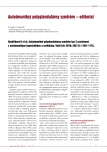Autoimmune polyendocrine syndrome type 2 associated with autoimmune hypophysitis and coeliac disease
Authors:
K. Hrubišková 1; P. Jackuliak 1; P. Vaňuga 2; M. Pura 2; J. Payer 1
Authors‘ workplace:
V. interná klinika Lekárskej fakulty UK a FNsP Bratislava, Slovenská republika, prednosta prof. MU Dr. Juraj Payer, CSc. 2Endokrinologické oddelenie Národného endokrinologického a diabetologického ústavu n. o. Ľubochňa, Slovenská republika, prednosta prim
1
Published in:
Vnitř Lék 2010; 56(11): 1169-1176
Category:
Case Reports
Overview
Autoimmune polyendocrine syndromes (APS) are organ‑ specific autoimmune disorders affecting multiple endocrine glands; these are gradually destroyed by action of autoantibodies. Similarly to other autoimmune diseases, the presence of certain genetic predisposition is an essential prerequisite to the disease development; polymorphism of the main histocompatible system (HLA in humans) appears to play the most important role. APS are categorized into four types, based on what combination of endocrine glands is affected. APS type 1, characterised by hypoparathyreosis, mucocutaneous candidiasis and Addison’s disease, is frequently seen in childhood. For a more common APS type 2 to be diagnosed, Addison’s disease together with autoimmune thyroiditis (Schmidt’s syndrome) and/ or together with diabetes mellitus type I (Carpenter’s syndrome) must be present. The third type of autoimmune polyendocrine syndromes (APS type 3) involves the same disorder of endocrine glands as type 2 but usually without any defect of adrenal cortex. If the autoimmune endocrine gland disorder does not fulfil the criteria of APS 1– 3, the disease may be categorized as autoimmune polyendocrine syndrome type 4. The authors present a case of 33 years old APS type 2 patient who, over 20 years, developed a wide range of autoimmune endocrinopathies, including endocrinopathies that are less common, such as adenohypophysitis, and are associated with other organ‑ specific diseases (coeliac disease). The case is presented to demonstrate the fact that APS represent a dynamic process and that it is always important to keep in mind that, over time, a patient may develop other autoimmune diseases. To conclude, the authors emphasise the recommendation to test patients with monoglandular endocrinopathy for the presence of any secondary endocrine disorders.
Key words:
autoimmune polyendocrine syndrome – hypophysitis – diabetes mellitus – coeliac disease
Sources
1. Betterle C, Zanchetta R. Update on autoimmune polyendocrine syndromes (APS). Acta Biomed 2003; 74: 9– 33.
2. Neufeld M, Blizzard RM. Polyglandular autoimmune diseases. In: Pinchera A, Doniach D, Fenzi GF et al (eds). Symposium on autoimmune aspects of endocrine disorders. New York: Academic Press 1980: 357– 365.
3. Rioux JD, Abbas AK. Paths to understanding the genetic basis of autoimmune disease. Nature 2005; 435: 584– 589.
4. Muir A, She JX. Advances in the genetics and immunology of autoimmune polyglandular syndrome II/ III and their clinical applications. Ann Med Interne 1999; 150: 301– 312.
5. Majeroni BA, Patel P. Autoimmune polyglandular syndrome, type II. Am Fam Physician 2007; 75: 667– 670.
6. Betterle C, Dal Pra C, Mantero F et al. Autoimmune adrenal insufficiency and autoimmune polyendocrine syndromes: autoantibodies, autoantigens and their applicability in diagnosis and disease prediction. Endocr Rev 2002; 23: 327– 364.
7. Hrdá P, Šterzl I. Autoimunitní polyglandulární syndromy. Alergie 2001; 2: 126– 129.
8. Shoenfeld Y, Blank M, Abu‑ Shakra M et al. The mosaic of autoimmunity: prediction, autoantibodies and therapy in autoimmune diseases – 2008. Isr Med Assoc J 2008; 10: 13– 19.
9. Collin P, Kaukinen K, Välimäki M et al. Endocrinological disorders and celiac disease. Endocr Rev 2002; 23: 464– 483.
10. Caturegli P, Newschaffer C, Olivi A et al. Autoimmune hypophysitis. Endocr Rev 2005; 26: 599– 614.
11. Gutenberg A, Buslei R, Fahlbusch R et al. Immunopathology of primary hypophysitis: implication for pathogenesis. Am J Surg Pathol 2005; 29: 329– 338.
12. Tanaka S, Tatsumi K, Kimura M et al. Detection of autoantibodies against the pituitary‑ specific proteins in patients with lymphocytic hypophysitis. Eur J Endocrinol 2002; 147: 767– 775.
13. Šterzl I, Hrdá P. Imunoendokrinní onemocnění: lymfocytární hypofyzitida. Sanquuis 2008; 58: 81– 83.
14. Dittmar M, Kahaly GJ. Polyglandular autoimmune syndromes: immunogenetics and long‑term follow‑up. J Clin Endocrinol Metab 2003; 88: 2983– 2992.
15. Vondra K, Vrbíková J, Šterzl I. Tyreoidální autoimunita u dospělých diabetiků 1. typu. Vlastní zkušenosti z 11letého sledování. Vnitř Lék 2006; 52: 864– 872.
Labels
Diabetology Endocrinology Internal medicineArticle was published in
Internal Medicine

2010 Issue 11
Most read in this issue
- Central hemiparesis as manifestation of systemic vasculitis
- Autoimmune polyendocrine syndrome type 2 associated with autoimmune hypophysitis and coeliac disease
- Lymphoma‑like course in aggressive adult multisystem Langerhans cell histiocytosis and the benefit of PET/ CT imaging in evaluation of diffuse metabolic activity of lung parenchyma
- Determination of the progression of prostate cancer using RT‑PCR method
